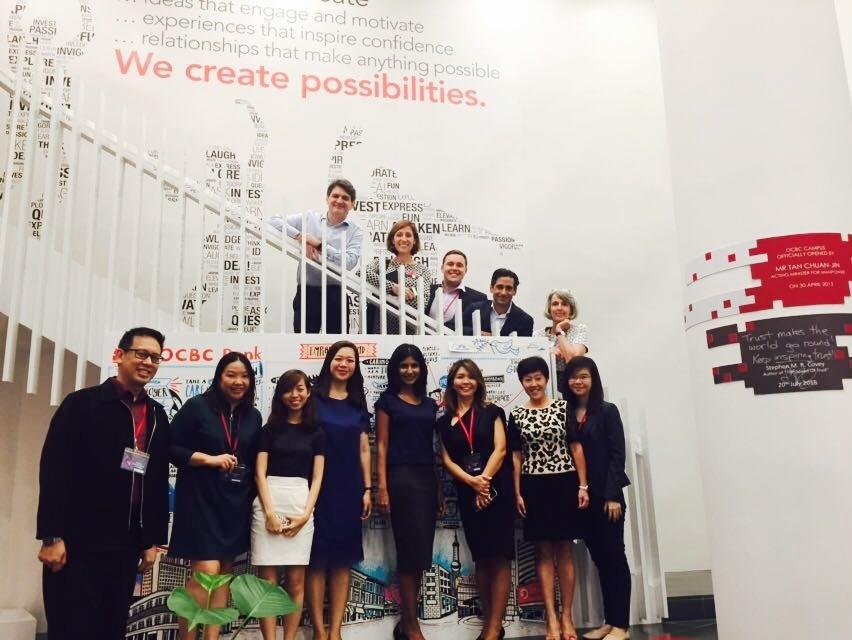How to use Design Thinking in HR
Posted by Alexandra Lamb
Design Thinking as a concept is enjoying notoriety across most business functions, following other powerful trends in process improvement and project management such as LEAN and AGILE etc. In each instance, businesses look to finesse performance by adapting frameworks from their native uses (e.g. software development, manufacturing efficiency, or product design) to be applied in new scenarios.
In the case of Design Thinking for HR specifically, we aim to drive strategic effectiveness by bringing an innovation mindset from the design world into our programs, unlocking new opportunities for performance through an employee-centered platform and change-agile culture. And, as Bersin, Solow and Wakefield (2016) put it:
“Design thinking casts HR in a new role. It transforms HR from a “process developer” to an “experience architect.” It empowers HR to reimagine every aspect of work: the physical environment; how people meet and interact; how managers spend their time; and how companies select, train, engage, and evaluate people.”
What is Design Thinking anyway?
Design Thinking is a framework for collaboration and innovation, and as the name suggests, it is a way of thinking first and foremost.
There are several schools of thought around its accompanying processes and methodologies (most notably from the Stanford d.School), each with its own appealing visuals. Mootee (2013) from Idea Couture points out that the business world may have romanticised and over simplified these concepts (apologies to all the core Designers and Strategists out there!), however even these basic visual models offer a significant contribution to good HR work. So, whether you think in loops, circles, stars or squiggles, the fundamental concepts of Design Thinking propose that our HR initiatives should be human centered, iterative and powered by insights.
Human Centered: The team at IDEO describe the essence of Design Thinking as: “…a process that starts with the people you’re designing for and ends with new solutions that are tailor made to suit their needs.”
Why is Design Thinking important for HR?
This is an important concept for HR, compounded by the fact that we have two (or often more) distinct yet overlapping groups of end-users to design for: our business leaders, our employee populations, and our business customers for whom all our programs are designed to ultimately benefit. Each group has needs, and sometimes those needs are competing.
It’s no surprise then that HR has predominantly invested in designing processes, tools, and cultures to meet the needs of business leaders, trusting that they will act in the service of customers, while retroactively fitting our solutions onto staff populations through ‘engagement’ initiatives.
The subtle shift that Design Thinking brings to our programs of work therefore lies in the opportunity to design for multiple end users, bringing the profile of the employee into sharper focus as a key stakeholder.
Bringing employees into the design equation as stakeholders and users, not simply recipients of programs that are aimed ‘at’ them, is an important nuance. It has significant repercussions for ROI.
BOLDLY's workshop on Design Thinking for HR and Talent Teams is designed for HR teams who are looking to re-imagine their talent programs. Coaches work alongside participants to define boundaries so that the full gamut of Human Resource programs are designed to create the necessary business impact.
How does Design Thinking for HR help in defining user profiles?
Perhaps you’re thinking: ‘but we run a regular engagement survey – we’re asking what employees want, and we’re transparent in acting on what we hear’.
If there’s something that stands out in the Human Centered Design method, and psychology more broadly, it’s that you can’t just ‘listen’ to what’s said explicitly, because people don’t always consciously know what they want or need and are often curating socially-acceptable messages rather than revealing their own truths.
That’s not to discredit our staff – it’s just the way the human mind works. We’re not always hyper conscious of our true drivers. The proof is in behaviour and action.
Design Thinking Take-Away: invest time in directly observing and defining your user profiles, and design your initiative with each major stakeholder group in mind.
How does Design Thinking foster a growth mindset?
Iterative: The value of iteration to the HR function is key.
To get results, we must ensure we don’t slip into a ‘fixed’ mindset, but rather expect to continuously prototype, test and challenge our assumptions, analyze and refine our programs of work, and go beyond our pre-conceived ‘rules’.
The concept of pilots are well accepted in HR, however we don’t often bring the element of radical thinking to our design, and in the pursuit of business case results it can sometimes seem like iteration is a luxury.
To think like a designer, HR must be willing to take a ‘growth’ mindset across the team – one set by curiosity, and continuous improvement through effort and collaboration.
HR teams across the region are well-versed in Carol Dweck’s work on this topic – we can use this concept to consider how we incentivize and cultivate the right attitudes in our talent teams to foster innovation from HR.
Through the iterative process, HR can observe where it’s appropriate to bring divergent thinking where wild, ‘nothing is too out there’ ideas can be discussed and celebrated, versus convergent thinking where the HR team eventually gets down to the nuts-and-bolts of bringing a realistic initiative to life.
Design Thinking Take-Away – through the piloting phase, don’t be too eager to commit to a concept or design principle.
“One of the biggest hurdles to overcome is the attachment to a ‘pet’ idea. You have to be willing to test your assumptions with employees and accept you may have it wrong. That’s why prototyping is such a powerful thing.” says Make Studios Director, Patti Hunt.
Embrace the ambiguity of a low-fidelity experience, because even through piloting you want to create an environment where feedback and group instincts have space to emerge and shape truly impactful initiatives.
Trust that the Design Thinking framework will do its job in your HR team culture, if you take the time and effort to invest in….
What insights can HR teams gain with Design Thinking?
Insights: Having a point of view and making sense of what you’re discovering through the Design Thinking process is key. This is a harder concept than it sounds, and should be constantly fine-tuned throughout the iterations of your pilot and beyond.
The team at Thrive define an insight as not just a simple observation or a summary of your data, but rather as:
- An unrecognized fundamental human truth.
- A penetrating observation about human behavior that results in seeing users from a fresh perspective.
- A discovery about the underlying motivations that drive people’s actions.
Sounds intimidating. You might be thinking: “Do I really need to put my finger on an unrecognized human truth?!”, and it’s true to say that articulating insights takes practice. But genuine insights come from the most unexpected places if you’re fostering a ‘no idea is a bad idea’ culture in your HR team.
Gaining insights is a matter of exercising empathy for your user groups, and can be validated by data collected through surveys, interviews, and importantly: observation etc.
Through these sources, we’re aiming to not only listen to what the end-users (e.g. business leaders, employees and customers) are saying and observing what they’re doing, but also to read what they’re thinking and feeling to infer those deeper insights.
The insight will be something that probably surprises you, like:
- Observation: Participation rates in our mandatory skills-training is low, and those who do attend were skeptical about the value of the program. Insight: Our staff require core skills, but want to have a choice in the programs they attend. This choice makes them feel like they’re being treated as adults. Pilot test: Engage staff by giving choices, big and small, wherever possible. Measure participation rates, but also translation of skills aquired to customer feedback.
- Observation: Our Managers often complain that they don’t have enough time to coach their direct reports 1:1. Insight: They do have time, but they’re feeling insecure in their ability to have real coaching conversations, and are unsure how they’ll manage the intensity of this staff relationship when times are tough for the team. Pilot test: Offer training on the role of the Coach and role of the Manager, and how/when to navigate each. Showcase examples where strong professional staff relationships allow Managers to give tough feedback more effectively.
- Observation: Our business Leaders want to see more accountability from their Managers, but when we join their team meetings we see they’re not sharing critical business goals with them. Insight: They’re feeling some apprehension because of a belief that they need to shield their direct reports from business pressure. In their mind, the role of the Leader is protective and paternal. Pilot test: Equip Leaders with the tone and narrative to share appropriate information with their teams, enlisting their resources to collaborate on critical business actions.
- Observation: Millennial candidates appear to be non-committal to their roles. They have a higher turn-over rate, and vocalize restlessness in their jobs more. Insight: They want to get a view of their possible future career, and see if we have a vision for them from the outside before they join. They’re wondering what the world of work will look like during their careers, just like the rest of us are. Pilot test: Infrastructure for reverse mentoring to open dialogue about careers between Millennials and their senior peers, building more insight and resources for each group.
Insights are subjective, bringing together both your observations as well as the intuitions of the HR team.
Don’t worry about being ‘right’, but do test your assumptions in a variety of ways. The better you know each of your end-user profiles, the more confident you can be in honing and eventually acting on the insights gained through the process.
And why NOW, HR?
The market demands it, and our businesses are inviting us to ratchet-up our strategic impact.
HR has been ‘transforming’ and advancing its perceived importance to business strategy globally for some time, and this is now particularly the case in Asia (where I’m based!).
Forces in this region are varied, however in each country in Asia we see the impact of digitization on productivity; big-data offering nuanced consumer insights; the gig and sharing economies rapidly becoming the new-normal; Xillennials (yes… that’s the upper end of the Millennials’ cohort) reaching leadership roles, and Gen Z now on the precipice of entering the workforce; low unemployment and high demand for specialized professionals; and yet automation, AI and machine learning posing sudden shifts to our workplaces and lifestyles.
Phew… it’s complex.
Consumers in this new marketplace have come to expect high standards of service delivery, personalized messaging, on-demand entertainment and abundance of choice. It’s natural for these expectations to carry over into how individuals expect to engage in the workforce as employees.
The same Design Thinking principles that have escalated consumer anticipation now pose a solution for HR who seek to create the same engagement in their workplaces, personalizing journeys to enable productivity.
At a recent event co-hosted by OCBC and Chapman Group at OCBC’s Singapore learning campus the application of Design Thinking in HR was on display. Lucienne Blessing from Singapore University of Technology and Design, Bojan Blecic, SVP and Head of Experience Design at OCBC, and Aye Wee Yap, Head of Learning & Development OCBC, offered insights from customer experience that are being directly translated into the employee experience lifecycle.
Each speaker demonstrated how using Design Thinking to reduce complexity in HR processes had demonstrably broken down barriers for employees to ‘opt-in’ to the business and spend their discretionary effort to perform, by shifting focus from ‘isolated touch points’ (such as the hiring event or performance management meeting) to the continuum of the whole employee journey.
In the OCBC case study, the bank has clearly learned from its external customers to re-frame and visualize the value it wants to drive for its employees. The concept of ‘withnessing’ demonstrated the collaboration and empathy required to design with employees in mind.
This conversation carried over into the participant groups. Paula Day, Principal Organisational Development Consultant, APAC from Oracle commented that Design Thinking has become crucial for HR because businesses essentially require more agility (both in individual mindsets and in organisational culture itself) to compete and survive in the new marketplace, and see the HR function is positioned to enable this agility.
The old ‘resources first’ approach to designing for employees is being replaced by a user experience and capability-first mindset, and the ‘F word’ (Failure… or rapid prototyping) is becoming more acceptable… so long as it’s accompanied by learning and iteration.
Design thinking ideally drives dialogue, which gives employees a sense of being close to the source of power to fix the problems they experience. “If the organization has a feedback mechanism to get insights directly back to designers and decision makers, staff are more likely to give input because they have the sense they can have an impact” says Paula.
And yet we need to be thoughtful about the Frankensteins we create.
The paradox of over-delivering ‘wow’ factors in employee-centered design, and focusing on quick-wins rather than deep insights (like offering free lunch, yoga rooms, laugh therapists, and massage angels in the office to drive engagement by integrating lifestyle into the workplace etc.) can inadvertently desensitise staff to ongoing efforts towards genuine and sustainable engagement.
What Design Thinking isn’t: bells and whistles!
HR can apply Design Thinking across any manner of workstreams to ensure we’re crafting strong user experiences to drive sustainable business impact.
As we mark the 20th anniversary since Ulrich’s HRBP model took precedent as best practice, Njemanze (2016) and other industry voices rightly call out HR’s opportunity to continue leaning into the role Ulrich describes as ‘the credible activist’ as we continue on our evolution as a function.
Design Thinking is one way for us to continuously strengthen and integrate the strategic presence we have in our businesses, and plus… it can be really fun along the way.
If you're interested in learning more about how BOLDLY can help your organisation, we invite you to explore our website or write to us at connect@boldly.app.
About the Author:
Alexandra Lamb is an accomplished organisational development practitioner, with experience across APAC, North America, and MENA. With 20+ years in professional practice, conglomerates, and startups, she has collaborated with rapid-growth companies and industry innovators to develop leaders and high-performance teams. She is particularly experienced in talent strategy as a driver for business growth. Drawing from her experience in the fields of talent management, psychology, coaching, product development, and human-centred design, Alex prides herself on using commercial acumen to design talent solutions with true impact.




